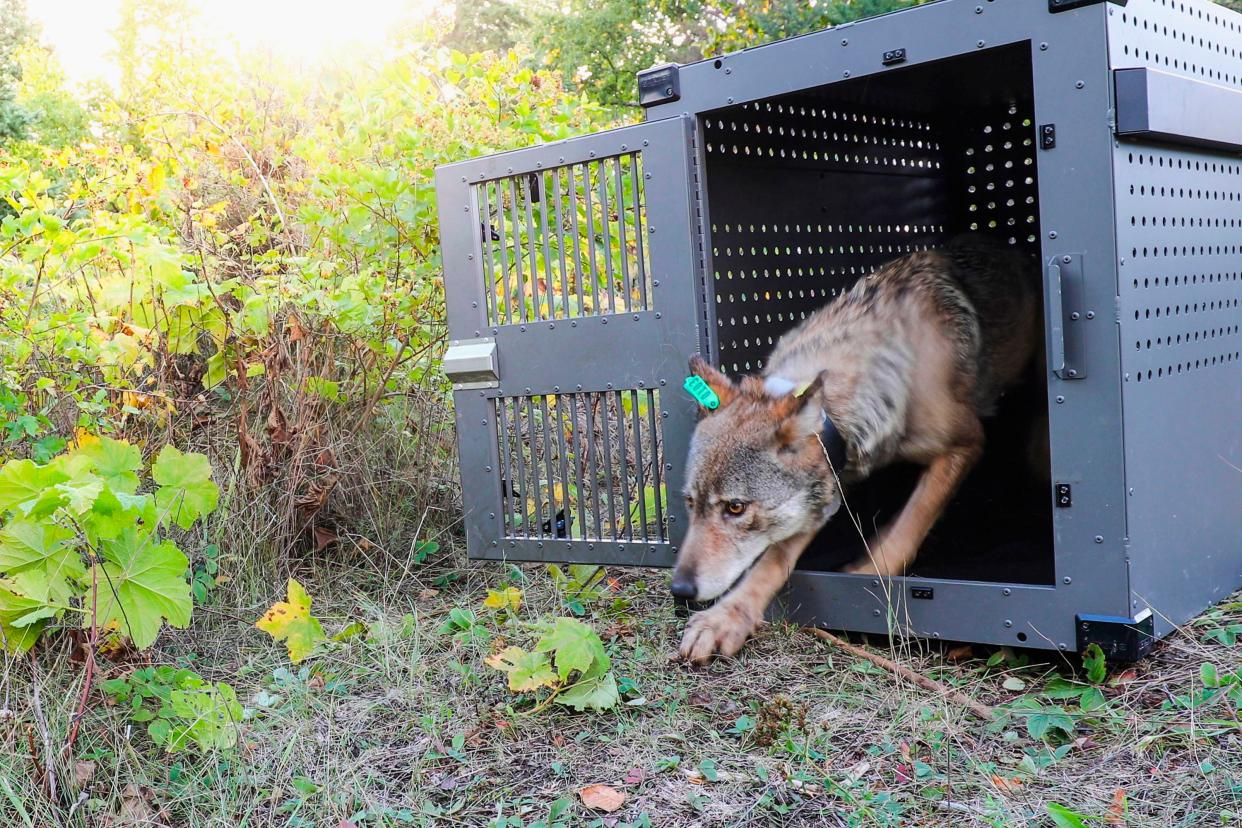Michigan DNR releases 2022 wolf population survey

UPPER PENINSULA — The Michigan Department of Natural Resources recently released its 2022 Upper Peninsula Gray Wolf Population Survey, highlighting the stability of the wolf population.
The survey recorded 631 wolves, plus or minus 49 wolves. A total of 136 packs were estimated in the survey, with an average of 4.5 wolves per pack.
“The results of our last survey show the population is stable,” said Brian Roell, a Marquette-based wildlife biologist with the DNR. “We have reason to believe gray wolves may have reached their biological carrying capacity in the UP.”
The DNR conducts a wolf population survey every other winter. Because the population has consistently been estimated between 618 and 695 since 2011, it is believed U.P. wolves have reached the maximum population their habitat can sustain. Several factors, including food, water, shelter and conflicts with humans influence how many wolves can coexist with other wildlife and human habitations in the U.P. According to the DNR, the fact that the wolf population has remained stable for a decade suggests the current population has reached an equilibrium that should be maintained.
More:Researchers watch Isle Royale wolf survive fall through Lake Superior ice
One noted change, however, was a shift in wolf density from the western U.P. to the eastern U.P. According to the DNR, there may be a link between significant winter weather events that reduced deer densities in mid-and-high snowfall zones in 2013, 2014 and 2015 and a shift in wolf density away from those zones.
“While that doesn’t mean wolves in the western U.P. migrated to the eastern U.P., it does mean the western U.P. wasn’t able to sustain as many wolves, and the eastern U.P. was,” said Roell.
The densest region for wolves in 2022 was the Unit 19 and 20 corridors between I-75 and Newberry, including much of Luce, Chippewa, and Mackinac counties. Roell said the DNR will not consider 2022's population density shift a permanent change unless the new population density stays the same in future surveys.
More:Gray wolf confirmed on Little Traverse Bay Bands of Odawa Indians Reservation
Wolves are one of the most controversial animals in the U.P., and the DNR works to dispel myths surrounding them. For example, wolves are often the first-named scapegoat when hunters can't get a deer in any given season. In truth, coyotes and black bears are each responsible for more deer predation than wolves. Another myth is that there are far more wolves in the U.P. than the population survey shows.
“It’s true that our population estimate is a minimum estimate,” said Roell. “It’s not that there are definitively 631 wolves plus or minus 49 wolves. It’s that we can prove 649 wolves, plus or minus 49. There might be more. But there are not thousands more. That’s a myth.”
Another common concern is wolf-dog conflicts. It’s important to note that wolf-dog conflicts almost entirely occur between wolves and hunting hounds. For example, 63 of the 72 dogs killed by wolves in the U.P. since 2009 were hunting hounds. And while there is no cause-and-effect relationship between shifts in wolf population and numbers of wolf-hunting hound conflicts, hunters can take steps to reduce wolf-hunting hound conflicts.
“Dogs in the U.P. have a greater chance of being hit by a car than being attacked by a wolf,” Roell said. “However, wolf-dog conflicts do happen, and that’s why we’ve put out guidelines for how hunters can keep their hounds safe from wolves.”
Subscribe:Get unlimited access to our coverage
From the DNR, four of the guidelines for peaceful coexistence with wolves include:
Report all suspected wolf-dog conflicts to the DNR immediately to allow a timely investigation
Become familiar with coyote and dog tracks, so they can be correctly distinguished from wolf tracks
Consider adding bells or beepers to dog collars — some hunters have reported this can reduce wolf attacks
Remain up-to-date on wolf-dog conflicts in the area you plan to recreate or hunt by periodically checking the map of wolf-dog conflict events
DNR officials said gray wolves play a crucial role in the ecosystems in which they live. Further, they are on the federal list of threatened and endangered species. That means they cannot be killed legally unless in defense of human life.

Their status as a threatened and endangered species has shifted over the years. The gray wolf was delisted in 2020, but was reinstated in 2022.
According to the U.S. Fish and Wildlife Service, a Feb. 10, 2022 court order stated that gray wolves in the contiguous 48 states and Mexico — with the exception of the Northern Rocky Mountain population — are now protected under the Endangered Species Act (ESA) as threatened in Minnesota and endangered in the remaining states. Critical habitat for gray wolves in Minnesota and Michigan and the 4(d) rule for gray wolves in Minnesota are also reinstated.
For public comment opportunities and guidelines regarding wolves in the Upper Peninsula, visit the Wolf Management Advisory Council's website.
Ren Brabenec is a Brimley-based freelance writer and journalist with The Sault News. He reports on politics, local issues, environmental stories, and the economy. For questions, comments, or to suggest a story, email hello@renbrabenec.com.
This article originally appeared on The Sault News: Michigan DNR releases 2022 wolf population survey

